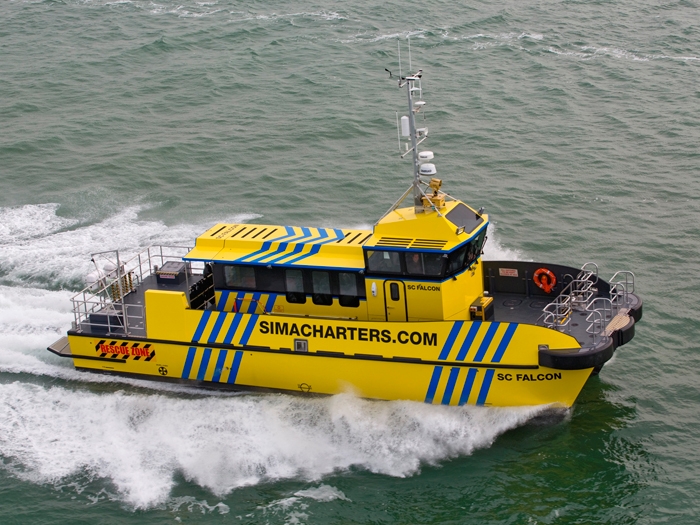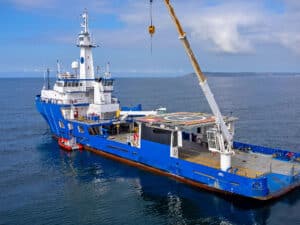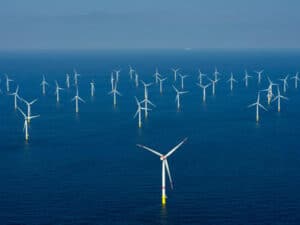
CTruk bonds with Crestomer
Written by Nick Blenkey
SC Falcon, which successfully completed sea trials in February 2014 and which is now in service, is the most recent CTruk offshore wind farm support vessel (OWSV) to be designed and fabricated using advanced composite materials and Crystic Crestomer bonding technology.
MAY 7, 2014 — CTruk Boats Ltd., Brightlingsea, Essex, U.K., is using Scott Bader’s Crystic Crestomer 1152PA urethane acrylate structural adhesive, for all FRP bonding in the multi-purpose composite marine craft that it designs and builds.
CTruk’s vessels are used as workboats for offshore wind farm support, with customized vessels being built for military, security, disaster relief and commercial applications.
The company’s business mission is to provide safe, fast and highly flexible working vessels by taking an innovative design approach.
The company’s patented modular pod system was initially created to meet the complex requirements of offshore wind support work and is a key example of CTruk’s innovative design approach.
Unique “moveable” FRP deck pods enable an operator to change the vessel’s functionality in just a few hours.
To minimize laminate weight and increase productivity, CTruk uses vacuum resin infusion processing technology along with advanced composite materials. Only materials and processes that have been fully approved by DNV and BV are used in production. These include Scott Bader’s Crystic Crestomer 1152PA urethane acrylate structural adhesive.
The adhesive is specified in all CTruk composite marine craft for structurally bonding in hull stringers and bulkheads, transom sections, engine beds, deck sections and for hull to deck joints.
“As we manufacture vessels to full marine classification, the company must use materials that have gone through rigorous type-approvals,” says Jim Cutts, CTruk’s Director of Engineering. “The CTruk design team only specifies proven products that are known to meet DNV and BV requirements with reliable and consistent results. Crestomer 1152 is one such product, giving the advantages of high-elongation, toughness and impact resistance at an economical cost.”
According to CTruk, depending on the application area and vessel specification, most FRP joints must also be over-laminated. However, as saving weight and production costs are key objectives, the CTruk design team is constantly looking to identify any new areas where it is possible to only bond with Crestomer.
“Whilst most of CTruk’s construction applications for Crestomer 1152 include an over-laminating procedure, we do also use purely bonded connections in a number of areas, such as some structural flanged connections,” says Seb Shillaker, Head of Production. “This gives us clear advantages, with savings on labor, materials and a lower overall vessel weight.”
Any design change must comply with DNV and BV standards, therefore any new applications using only adhesive joints (with no over-laminating) must be submitted for approval, along with detailed calculations. The CTruk design team usex Finite Element Analysis (FEA) to ensure that hull and deck structures meet rigorous strength criteria and comply with the relevant class specifications.
CTruk has successfully obtained approvals for certain FRP bonding only application areas, so that in current craft build specifications the main deck beam, in spite of it being a high impact area, is now also joined only using Crestomer 1152PA structural adhesive, as well as some of the hull and deckhouse structural flange connections.
CTruk was confident in gaining these “bonding only” application approvals due to its rigorous design criteria and the fact that Crestomer 1152PA, like all products in the Crestomer range, has approvals from DNV, RINA and Lloyds Acceptance (Statement of Acceptance MATS/1785/3) for use as structural adhesives in the most critical FRP bonding marine applications and are well proven in use.
Published Scott Bader technical data for cured Crestomer 1152PA give typical physical property values of 100% elongation at break and a maximum tensile strength of 26 MPa (to BS EN ISO 527-2:1196 test method); the limiting factor is the fiberglass substrate failure, not the Crestomer adhesive joint strength.
Crestomer 1152PA is MEKP cured, supplied to CTruk pre-accelerated in 25 kg pails, and is applied by hand. It offers a good level of application flexibility on the shop floor during the bonding assembly stage, as the Crestomer 1152PA grade has an open working time of up to 50 minutes (at 2% w/v catalyst, 25°C) and is suitable for gap-filling joints up to 25mm.





Leave a Reply
You must be logged in to post a comment.